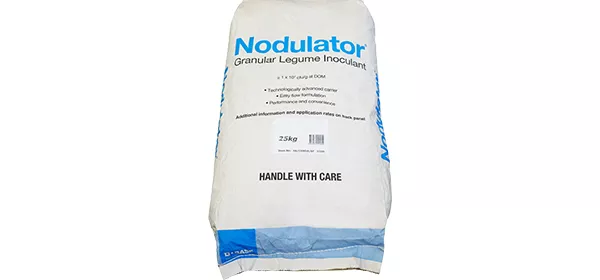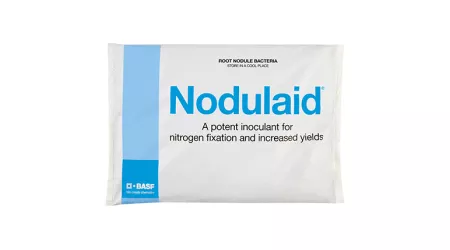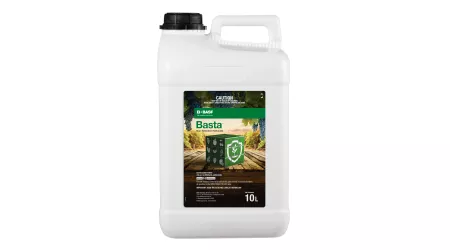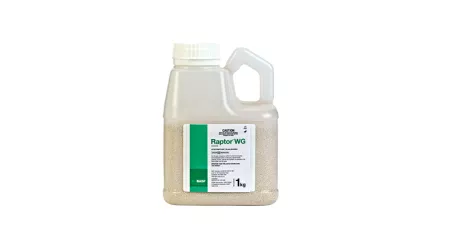Hear what Australian growers have to say about Nodulator
Key benefits
- Smooth, evenly sized granules provide superior fl ow, more accurate metering and even distribution in the planting furrow.
- Application into the furrow reduces compatibility issues and protects the live organisms from hot or dry surface conditions and chemical treatment.
- At least 6 weeks’ inoculant life in the soil allows early dry sowing ahead of rain.
- Lower rates for wider rows mean extra convenience and cost-effectiveness.
How it works
Nodulator® contains over one million live rhizobia per gram. The rhizobia are ‘captured’ by the growing roots of the crop and form a symbiotic relationship that promotes nodulation. The nodules that grow on the roots produce enough nitrogen to both increase the growth and yield of the host plant itself and leave sufficient residual nitrogen in the soil to feed the following crop.
Applying Nodulator into the furrow reduces compatibility issues and protects the live organisms from hot or dry surface conditions and chemical treatment.
You can learn more about the scientific principles behind the yield boost inoculants provide by watching the video below.
An insight into our inoculant production site in Somersby NSW
Crop suitability
-
Clover
Nitrogen deficiency -
Lucerne
Nitrogen deficiency -
Pasture (legumes)
Nitrogen deficiency -
Pulses
Nitrogen deficiency
Questions and Answers from the Field
-
Do you need to inoculate legumes?
It’s beneficial to inoculate legumes with a BASF inoculant product such as Nodulaid or Nodulator. Nodulaid and Nodulator stimulate nodulation. The nodules that then grow on the roots of legumes produce enough nitrogen to increase the growth and yield of the legume plants.
-
Does clover need an inoculant?
It’s important to inoculate clover with a BASF product such as Nodulaid or Nodulator. Nodulaid and Nodulator stimulate nodulation. The nodules that then grow on the roots of clover produce enough nitrogen to increase the growth and yield of the clover plants.
-
How long does Nodulaid inoculant survive when applied as a slurry to seed prior to sowing?
Sow within 24 hours of treating, or store for up to 3 days in a cool place, away from sunlight.
-
How long does inoculant persist in dry soil?
BASF’s Nodulator lasts for up to six weeks in the soil when applied into the furrow with an airseeder, allowing early dry sowing ahead of rain. BASF’s Nodulaid can last up to 7 days in dry soil when applied either: as a slurry to the seed, or in furrow.
-
What are inoculants for pastures and crops?
The ideal inoculants for pastures and crops are BASF’s Nodulaid and Nodulator. Nodulaid and Nodulator promote nodulation and produce enough nitrogen to increase the growth and yield of pastures and crops.
-
What is the inoculant for chickpeas?
A highly effective inoculant for chickpeas and other legumes is BASF’s Nodulaid or Nodulator. For a peat inoculant, it’s important to apply Nodulaid to the seed ahead of sowing. Or apply Nodulator (a granular inoculant) in the soil ahead of sowing to increase the growth and yield of chickpea crops.
-
What is nitrogen inoculant?
An ideal inoculant is a product such as BASF’s Nodulaid or Nodulator that create nodules in the plant root that convert nitrogen in the soil. These inoculants promote nodules that then grow on the roots and produce enough nitrogen to increase the growth and yield of plant crops and leave sufficient residual nitrogen to feed the future crop.
-
What is the best inoculant for beans?
The best inoculant for beans is BASF’s Nodulaid or Nodulator. For a peat inoculant, it’s important to apply Nodulaid to the seed ahead of sowing. Or apply Nodulator (a granular inoculant) in the soil ahead of sowing to increase the growth and yield of bean crops.
-
What is the best prevention of nitrogen deficiency?
The best prevention of nitrogen deficiency is to use a product such as Nodulaid or Nodulator. Nodulaid and Nodulator promote nodulation. The nodules that then grow on the roots produce enough nitrogen to increase the growth and yield of plant crops and leave sufficient residual nitrogen to feed the future crop and prevent future nitrogen deficiency.





